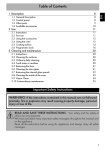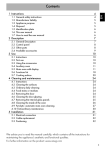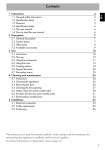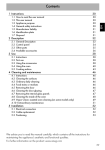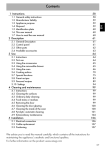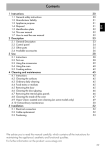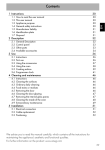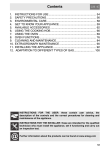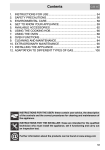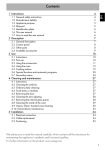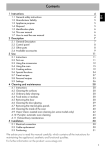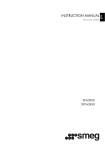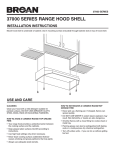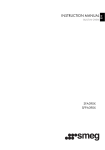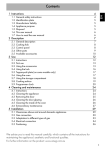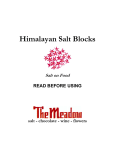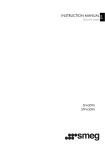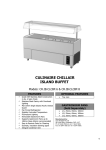Download Instruction manual
Transcript
Table of Contents 1.1 1.2 1.3 1.4 1.5 10 General Description Cooktop Control panel Other parts Available accessories 2 Use 2.1 2.2 2.3 2.4 2.5 2.6 2.7 2.8 10 10 11 11 12 14 Instructions First use Using the accessories Using the range top Using the storage compartment Using the oven Cooking advice Programmer clock 3 Cleaning and maintenance 3.1 3.2 3.3 3.4 3.5 3.6 EN 1 Description Instructions Cleaning the appliance Removing the door Cleaning the door glass Cleaning the inside of the oven Extraordinary maintenance 14 15 15 17 19 19 21 22 26 26 26 27 28 28 29 Important Safety Instructions WARNING: If the instructions contained in this manual are not followed precisely, fire or explosion may result causing property damage, personal injury or loss of life. • Do not store or use gasoline or other flammable vapors or liquids near this or any other appliance. WHAT TO DO IF YOU SMELL GAS • • • • Do not try to light any appliance. Do not touch any electrical switches. Do not use any telephones in your building. Immediately call your gas supplier from a neighbor’s phone. Follow the gas supplier’s instructions. • If you cannot reach your gas supplier, call the fire department. • Installation and service must be performed by a qualified installer, service company or gas supplier. 3 Important Safety Instructions TIP OVER HAZARD WARNING • A child or adult can tip the range and be killed. • Make sure that the anti-tip device has been properly installed and attached. The wall-mounted brackets should anchor the sides of the range (primary system) or, in case of floormounted brackets, they should anchor the rear of the range to the ground. • Make sure that the anti-tip device is re-attached when the range is moved. The wall-mounted brackets should anchor the sides of the range (primary system) or, in case of floormounted brackets, they should anchor the rear of the range to the ground. • Do not operate the range without the anti-tip device in place and attached. • Failure to do so can result in loss of life or serious burns to children or adults. READ AND SAVE THESE INSTRUCTIONS - Your safety and the safety of others are very important. We have provided many important safety messages throughout this manual and on the appliance. Read all the instructions before using the appliance and always obey all safety messages. RECOGNIZE SAFETY INFORMATION This is a safety alert symbol. This symbol alerts you to potential hazards that can result in severe personal injury or loss of life. UNDERSTAND SIGNAL WORDS A signal word - DANGER, WARNING or CAUTION - is used with the safety alert symbol. DANGER denotes the most serious hazards. It means you could lose your life or be seriously injured if you do not immediately follow the instructions. WARNING means you could lose your life or be seriously injured if the instructions are not followed. CAUTION indicates a potentially hazardous situation which, if not avoided, could result in minor to moderate injury. 4 Important Safety Instructions WARNING EN • This appliance is intended for use in the home only. • Use this appliance only for its intended purpose. The manufacturer cannot be held liable for damage caused by improper use of this range. • This appliance complies with current safety regulations. Improper use of this range can result in personal injury and material damage. • Read all the instructions before installing or using the range for the first time. • Keep these operating instructions in a safe place and pass them on to any future user. The safety messages will inform you of potential hazards, on how to avoid the risk of injury and what can occur if the instructions are not followed. IMPORTANT: Observe all codes and ordinances in force. NOTE: This range is manufactured for use with natural gas. To convert the appliance to LP/Propane gas, see the instructions in the Gas Conversion Kit provided in the literature package. The proper gas supply connection must be available. See “Gas supply requirements”. WARNING: For your safety, the instructions contained in this manual must be followed to minimize the risk of fire or explosion and to prevent property damage, personal injury or loss of life. Do not store or use gasoline or other flammable vapors, liquids or materials near this or any other appliance. NOTE: This range is NOT designed for installation in manufactured (mobile) homes or in recreational vehicles (RVs). DO NOT install this range outdoors. WARNING To reduce the risk of fire, electrical shock, personal injury, or damage when using the range, follow basic safety precautions, including the following: 5 Important Safety Instructions WARNING PRIMARY FASTENING SYSTEM: Visually check that the wall-mounted brackets are inserted into the appropriate lateral hooks (on both sides). SECONDARY FASTENING SYSTEM: Visually check from the inside of the drawer that the floor-mounted bracket is inserted into the appropriate lateral hooks (left or right). • Proper installation is your responsibility. Make sure your appliance is properly installed and grounded by a qualified installer. • WARNING: NEVER use this appliance as a space heater to heat or warm the room. Doing so may result in carbon monoxide poisoning and overheating of the oven. • DO NOT LEAVE CHILDREN UNATTENDED: Children should not be left alone or unattended in the area where the appliance is being used. Never allow children to sit or stand on any part of the appliance. • CAUTION - Do not store items of interest to children in cabinets above a range or on the backguard of a range - children climbing on the range to reach items could be seriously injured. • WEAR PROPER APPAREL: loose-fitting or hanging garments should never be worn while using the appliance. • For safety reasons and to avoid damage to your appliance, never sit, stand or lean on the oven door. 6 • FLAMMABLE MATERIALS SHOULD NEVER BE STORED IN THE OVEN OR NEAR THE SURFACE BURNERS. • GREASE IS FLAMMABLE: Allow hot grease to cool before attempting to handle it. Do not allow deposits of grease to accumulate. • DO NOT USE WATER ON GREASE FIRES: Turn the appliance off and smother the fire with baking soda or use a dry chemical or a foam-type extinguisher. • USE ONLY DRY POTHOLDERS: Moist or damp potholders on hot surfaces may cause burns from steam. Do not allow potholders to touch hot surface burners. Do not use towels or other bulky cloth in place of potholders. • Never allow garments, potholders or other flammable materials to come into direct or indirect contact with burners until they have completely cooled. • DO NOT TOUCH SURFACE BURNERS OR THE INSIDE OF THE APPLIANCE: Heating elements may be hot even though they are dark in color. The oven cavity can be hot enough to cause burns. During and after use, do not touch areas near burners or the inside of the oven until they have had sufficient time to cool. Do not allow garments or any flammable material to come into contact with hot surfaces. If personal clothing or hair catches on fire, drop and roll immediately to extinguish the flames. • PLACE THE OVEN RACKS IN THE DESIRED POSITION WHILE THE OVEN IS COOL: If a rack must be removed while the oven is hot, do not allow the potholders to come in contact with the broiler burner. • USE CAUTION WHEN OPENING THE OVEN DOOR: Allow hot air or steam to escape before removing or placing foods in the oven. • Do not leave the packing materials around the home. Sort the various items of waste and take them to the nearest specialized waste collection facility. • Do not obstruct oven vents or openings for air intake. • ELECTRICAL GROUNDING IS REQUIRED. It is the customer’s responsibility: 1 To contact a qualified electrician. 2. To ensure that the electrical system is adequate and in compliance with the National Electrical Code ANSI / NFPA 70 Electrical Code – latest edition – Or the CANADIAN ELECTRICAL CODE, C22.11 – 1982 and C22.2 No. 01982 – or latest edition – and all local codes and ordinances. • Always check that the controls are in the "zero" (off) position when the range is not in use. • Use only pots or pans with a perfectly smooth, flat bottom on the range surface burners. NEVER USE THE RANGETOP AS A WORK SURFACE. • Do not attempt to repair or replace any part of this appliance unless specifically recommended in this manual. All other servicing should be done by a qualified technician. • Never use any part of the range or oven for storage. Flammable materials can ignite and plastic items may melt or burst into flame. • Do not hang articles on any part of the appliance or place anything against the oven. Some fabrics are extremely flammable and could ignite. • IMPORTANT: After a spill or boilover, turn off the burner and clean around it. After cleaning, check that the burner functions properly. 7 EN Important Safety Instructions Important Safety Instructions • DO NOT USE ALUMINUM FOIL TO LINE ANY PART OF THE OVEN OR RANGETOP. Use of a foil liner can result in an electrical shock or fire hazard or obstruct the flow of heat and air. Foil is an excellent heat insulator, allowing heat to be trapped under it. This can interfere with cooking and can damage the enamel of the oven. • Prevent aluminum foil from contacting the heating elements. • Never leave the range unattended when using high heat settings. Boilover can cause smoke and spattered grease can ignite. • Not all types of glass, thermally resistant glass-ceramic, ceramic, earthenware, or other glazed cookware are suitable for range use. This type of cookware can break with sudden temperature changes. Use only on low or medium heat settings in accordance with the instructions supplied by the manufacturer. • DO NOT HEAT UNOPENED FOOD CONTAINERS: A buildup of pressure can cause the containers to burst. • DO NOT USE FLAMMABLE PRODUCTS TO CLEAN THE RANGE. • Do not clean, rub, damage or remove the oven door gasket. It is essential for a good, tight seal during baking and when the self-clean cycle is engaged. Replace the oven door gasket if it becomes damaged or encrusted with food residue. • Be sure all range surface burner controls are turned off and that the rangetop is cool before using any type of cleaning product. The chemical elements in these products could, in the presence of heat, ignite or cause metal parts to corrode. • ONLY QUALIFIED SERVICE PERSONNEL SHOULD PERFORM REPAIRS. Service personnel must disconnect the power supply before servicing this unit. NOTE: The California Safe Drinking Water and Toxic Enforcement Act requires the Governor of California to publish a list of substances known to the State of California to cause cancer, birth defects or other reproductive harm, and requires businesses to warn customers of potential exposure to such substances. WARNING: This product contains a chemical known by the State of California to cause cancer, birth defects or other reproductive harm. This appliance can cause low-level exposure to some of the substances listed, including benzene, formaldehyde, carbon monoxide, toluene, and soot. 8 • Make sure that your range is properly secured and the anti-tip device is correctly installed. Refer to the instructions inside the installation manual. • Do not stand or sit on the oven door or drawer. • Remove all packing materials and temporary labels from the oven and rangetop. • Record the Model and Serial number on Page 2 of this booklet. The Model and Serial numbers are on the Range ID plate. The ID Plates are visibly located on the back of the appliance and on the oven door frame. THE ID PLATE MUST NOT BE REMOVED. • BEFORE BAKING OR BROILING FOR THE FIRST TIME, turn on the oven and broiler to burn off any dirt, oil or grease remaining from the manufacturing process. Turn the oven on and set to 450°F (230°C) for 20 to 30 minutes, then turn on the broiler for the same amount of time. How to read the user manual This user manual uses the following reading conventions: Instructions General information on this user manual, on safety and final disposal. Description Description of the appliance and its accessories. Use Information on the use of the appliance and its accessories, cooking advice. Cleaning and maintenance Information for proper cleaning and maintenance of the appliance. Safety instructions Information Advice 1. Use instruction sequence. • Single use instruction. SAVE THESE INSTRUCTIONS 9 EN Important Safety Instructions Description 1 Description 1.1 General Description 1 Backguard 2 Cooktop 3 Control panel 4 Oven light 5 Seal 6 Door 7 Fan 8 Storage compartment Rack/tray support frame shelf 1.2 Cooktop AUX = Auxiliary SR = Semi-rapid R = Rapid 10 UR2 int = Ultra rapid internal crown UR2 est = Ultra rapid external crown Description EN 1.3 Control panel 1 Temperature knob 5 Programmer clock This knob allows you to select the cooking temperature. Turn the knob clockwise to the required value, between the minimum and maximum setting. Useful for displaying the current time, setting programmed cooking operations and programming the minute minder timer. Shelves 2 Indicator light The indicator light comes on to indicate that the oven is heating up. It turns off as soon as it reaches the set temperature. It flashes regularly to indicate that the temperature set inside the oven is kept constant. The appliance features shelves for positioning trays and racks at different heights. The insertion heights are indicated from the bottom upwards (see 1.1 General Description). Cooling fan 3 Function knob The oven's various functions are suitable for different cooking modes. After selecting the required function, set the cooking temperature using the temperature knob. 4 Cooktop burner knobs Useful for lighting and adjusting the surface burners. Press and turn the knobs counter-clockwise to the value to light the relative burners. Turn the knobs to the zone between the maximum and minimum setting to adjust the flame. Return the knobs to the off the burners. 1.4 Other parts The fan cools the ovens and comes into operation during cooking. The fan causes a steady outflow of air from above the door which may continue for a brief period of time even after the appliance has been turned off. Interior lighting The internal light of the oven comes on when any function is selected. position to turn 11 Description 1.5 Available accessories Rack Some models are not provided with all accessories. Ring reducer Useful for supporting containers with food during cooking. Useful when using small cookware. Oven tray WOK ring Useful when using a wok. 12 Useful for collecting fat from foods placed on the rack above. Rotisserie rod The accessories intended to come into contact with food are made of materials that comply with the provisions of current legislation. Useful for cooking chicken and all foods which require uniform cooking over their entire surface. Rotisserie rack Supplied and optional accessories can be requested from Authorized Assistance Centers. Use only original accessories supplied by the manufacturer. Some models are not provided with all accessories. To be used to support the rotisserie rod. Rotisserie handle Useful for taking the rotisserie rod out of the oven. 13 EN Description Use 2 Use 2.1 Instructions High temperature inside the oven during use Danger of burns • Keep the oven door closed during cooking. • Protect your hands wearing heat resistant gloves when moving food inside the oven. • Do not touch the heating elements inside the oven. • Do not pour water directly onto very hot trays. • Do not allow children younger than 8 years old to come near the appliance when in operation. • If you need to move food or at the end of cooking, open the door 5 cm for a few seconds, let the steam come out, then open it fully. Improper use Danger of burns • Make sure that the flame spreaders are correctly positioned in their housings with their respective burner caps. • Oils and fat could catch fire if overheated. Be very careful. 14 Improper use Risk of damage to surfaces • Do not cover the bottom of the oven cavity with aluminum or tin foil sheets. • If you wish to use greaseproof paper, place it so that it will not interfere with the hot air circulation inside the oven. • Do not place pans or trays directly on the bottom of the oven cavity. • Do not use the open door to rest pans or trays on the internal glass pane. • Do not pour water directly onto very hot trays. • Make sure that the flame spreaders are correctly positioned in their housings with their respective burner caps. • The pots and pans or griddle plates should be placed inside the perimeter of the cooktop. • All pans must have smooth, flat bottoms. • If any liquid does boil over or spill, remove the excess from the cooktop. High temperature inside the storage compartment Danger of burns • Do not open the storage compartment when the oven is on and still hot. • The items inside the storage compartment could be very hot after using the oven. Use • Do not spray any spray products near the oven. • Do not use or leave flammable materials near the oven or the storage compartment. • Do not use plastic kitchenware or containers when cooking food. • Do not put sealed cans or containers in the oven. • Do not leave the oven unattended during cooking operations where fats or oils could be released. • Remove all trays and racks which are not required during cooking. 2.3 Using the accessories EN High temperature inside the oven during use Danger of fire or explosion Racks and trays Racks and trays have to be inserted into the side guides until they come to a complete stop. • The mechanical safety locks that prevent the rack from being taken out accidentally have to face downwards and towards the oven back. 2.2 First use 1. Remove any protective film from the outside or inside of the appliance, including accessories. 2. Remove any labels (apart from the technical data plate) from the accessories and from the cooking compartments. 3. Remove all the accessories from the appliance and clean them (see 3 Cleaning and maintenance). Heat the empty oven at the maximum temperature to burn off any residues left by the manufacturing process. Gently insert racks and trays into the oven until they come to a stop. Clean the trays before using them for the first time to remove any residues left by the manufacturing process. 15 Use Tray rack The tray can be used two different ways: • Inside the rack (with the anti-tip stop facing upwards) to collect grease during cooking. • Resting on the rack (with the anti-tip stop facing downwards) to cook sweets, biscuits, pastries etc. 2. Screw on the handle provided so that you can handle the rod with the food on it easily. 3. Once you have prepared the rotisserie rod, place it on the rotisserie rack. Insert the rod into the hole so that it connects with the rotisserie motor. Make sure that the contoured part is placed correctly on the guide frame and remove the handle. Rotisserie rod 1. Prepare the rotisserie rod with the food using the prongs provided. 4. To activate the rotisserie, turn the function knob to position 5. At the end of cooking, use the rotisserie handle provided to extract the rod from the hole and remove the rack in order to take the rotisserie rod out of the oven cavity. 16 Use EN 2.4 Using the range top WARNING FIRE HAZARD • For your safety: do not allow the burner flame to extend beyond the edge of the pan. These operations must be performed with the oven off and cold. Ring reducers The ring reducers have to be placed on the cooktop grates. Make sure they are properly placed. • Turn off all controls when the range is not in use. All the appliance's control and monitoring devices are located together on the front panel. The burner controlled by each knob is shown next to the knob. The appliance is equipped with an electronic ignition device. Simply press the knob and turn it counterclockwise to the maximum flame symbol, until the burner lights. If the burner does not light in the first 15 seconds, turn the knob to and wait 60 seconds before trying again. After lighting, keep the knob pressed in for a few seconds to allow the thermocouple to heat up. The burner may go out when the knob is released: in this case, the thermocouple has not heated up sufficiently. Wait a few moments and repeat the operation. Keep the knob pressed in longer. In case of an accidental turning off, a safety device will be tripped, cutting off the gas supply, even if the gas tap is open. Return the knob to and wait at least 60 seconds before lighting it again. 17 Use Correct positioning of the flame spreaders and burner caps Before lighting the cooktop burners, make sure that the flame spreaders are correctly positioned in their housings with their respective burner caps. Make sure that the holes in the flame spreaders (1) are aligned with the igniters (2) and thermocouples (3). Practical tips for using the cooktop For better burner efficiency and to minimize gas consumption, use pans with lids and of suitable size for the burner, so that flames do not reach up the sides of the pan. Once the contents come to a boil, turn down the flame far enough to ensure that the liquid does not boil over. Cookware diameters: • Auxiliary: 12 - 14 cm. • Semi-rapid: 16 - 24 cm. • Rapid: 18 - 26 cm. • Ultra-rapid: 18 - 28 cm. 18 Cookware Ideally, cookware should have a flat bottom, straight sides, a tight-fitting lid and medium-to-heavy thickness. Rough cookware finishes may scratch the rangetop. Aluminum and copper may be used in cookware as a core material or base. However, when used as a base they can leave permanent marks on the rangetop or grates. Cookware properties are a factor in how quickly and evenly heat is distributed, which affects cooking results. A non-stick finish has the same characteristics as its base material. For example, a non- stick finish on aluminum cookware will take on the properties of aluminum. Refer to the following chart as a guide to the physical properties of cookware. Aluminum • Heats quickly and evenly. • Suitable for all types of cooking. • Medium or heavy thickness is best for most cooking tasks. Cast iron • Heats slowly and evenly. • Good for browning and frying. • Maintains heat for slow cooking. Ceramic or glass-ceramic • Follow the manufacturer’s instructions. • Heats slowly but unevenly. • Best results with low to medium heat settings. Use 2.5 Using the storage compartment The storage compartment is at the bottom right of the range. It can be used to store cookware or metallic objects necessary when using the appliance. 2.6 Using the oven EN Copper • Heats very quickly and evenly. Earthenware • Follow the manufacturer’s instructions. • Use low heat settings. Porcelain enameled steel or cast iron • See stainless steel or cast iron. Stainless steel • Heats quickly but unevenly. • Stainless steel cookware with aluminum or copper as a core material or bottom provides even heating. WARNING BURN HAZARD • Keep the oven door closed during cooking. Turning the oven on To turn the oven on: 1. Select the cooking function using the function knob. 2. Select the temperature using the temperature knob. Functions list Static As the heat comes from top and bottom at the same time, this system is particularly suitable for certain types of food. Traditional cooking, also known as static cooking, is suitable for cooking just one dish at a time. Perfect for all types of roasts, bread and cakes and in any case particularly suitable for fatty meats such as goose and duck. Bottom element The heat coming just from the bottom allows you to complete the cooking of foods that require a higher bottom temperature, without affecting their browning. Perfect for cakes, pies, tarts and pizzas. 19 Use Small broiler + rotisserie The rotisserie works in combination with the central grill heating element and allows food to be perfectly browned. Broiler The heat coming from the broiler element gives perfect broiling results above all for thin and medium thickness meat and, in combination with the rotisserie (where fitted), gives the food an even browning at the end of cooking. Perfect for sausages, spare ribs and bacon. This function enables large quantities of food, particularly meat, to be grilled evenly. Convection broil The air produced by the fan softens the strong heatwave generated by the broiler, roasting perfectly even very thick foods. Perfect for large cuts of meat (e.g. pork shank). Convection fan The operation of the fan, combined with traditional cooking, ensures consistent cooking even with complex recipes. Perfect for cookies and cakes, even when simultaneously cooked on several levels. (For multiple-level cooking, we recommend using the 2nd and 4th shelves). 20 Convection bake The combination of the fan and the convection heating element (incorporated in the rear of the oven) allows you to cook different foods on several levels, as long as they need the same temperatures and same type of cooking. Hot air circulation ensures instant and even distribution of heat. It will be possible, for instance, to cook fish, vegetables and cookies simultaneously (on different levels) without odors and flavors mixing. Defrost Rapid defrost is helped by turning on the fan provided and the top heating element that ensure uniform distribution of low temperature air inside the oven. 2.7 Cooking advice General advice • Use a convection function to achieve consistent cooking at several levels. • It is not possible to shorten cooking times by increasing the temperature (the food could be overcooked on the outside and undercooked on the inside). Advice for cooking meat • Cooking times vary according to the thickness and quality of the food and to consumer taste. • Use a meat thermometer when roasting meat, or simply press on the roast with a spoon. If it is hard, it is ready; if not, it needs another few minutes cooking. Advice for cooking with the Broiler and the Convection broil • Meat can be grilled even when it is put into the cold oven or into the preheated oven if you wish to change the effect of the cooking. • With the Convection broil function, we recommend that you preheat the oven before grilling. • We recommend placing the food at the center of the rack. • With the Grill function, we recommend that you turn the temperature knob to the maximum value near the symbol to optimize cooking. • Foods should be seasoned before cooking. Foods should also be coated with oil or melted butter before cooking. • Use the oven tray on the first bottom shelf to collect fluids produced by grilling. • Grilling processes should never last more than 60 minutes. Advice for cooking desserts/pastries and cookies • Use dark metal baking pans/sheets: they help to absorb the heat better. • The temperature and the cooking time depend on the quality and consistency of the dough. • To check whether the dessert is cooked right through: at the end of the cooking time, put a toothpick into the highest point of the dessert. If the dough does not stick to the toothpick, the dessert is cooked. • If the dessert collapses when it comes out of the oven, next time reduce the set temperature by about 10°C (50°F), selecting a longer cooking time if necessary. • While cooking desserts or vegetables, excessive condensation may form on the glass. In order to avoid this, open the door very carefully a couple of times while cooking. 21 EN Use Use Advice for defrosting and proofing • Place frozen foods without their packaging in a lidless container on the first shelf of the oven. • Avoid overlapping the food. • To defrost meat, use the rack placed on the second level and a tray on the first level. In this way, the liquid from the defrosting food drains away from the food. • The most delicate parts can be covered with aluminum foil. • For successful proofing, a container of water should be placed in the bottom of the oven. To save energy • Stop cooking a few minutes before the time normally used. Cooking will continue for the remaining minutes with the heat which has accumulated inside the oven. • Reduce any opening of the door to a minimum to avoid heat dispersal. • Keep the inside of the appliance clean at all times. 2.8 Programmer clock 1 Minute minder timer key 2 Cooking duration key 3 End of cooking key 4 Value decrease key 5 Value increase key Please make sure the programmer clock shows the cooking duration symbol , otherwise the oven will not switch on. Press keys and at the same time to reset the programmer clock. 22 Setting the time If the time is not set, the oven will not switch on. On the first use, or after a power failure, the digits will be flashing on the appliance's display. 1. Press the and keys at the same time. The dot between the hours and the minutes flashes. 2. The time can be set using or . Keep the key pressed in to increase or decrease rapidly. 3. Wait approx. 5 seconds without pressing any key in order for the function to activate. The current time and the symbols and will appear on the display. 4. At the end of cooking the heating elements will be deactivated. On the display, symbol turns off, symbol flashes and the buzzer sounds. 5. To turn off the buzzer just press any key of the programmer clock. 6. Press keys and at the same time to reset the programmer clock. 3. Press the key or wait 5 seconds. The dot between the hours and the minutes stops flashing. It is not possible to set a cooking time of more than 10 hours. 4. The symbol on the display indicates that the appliance is ready to start cooking. After the setting, to display the cooking time left press the key. Timed cooking To reset the set program, press keys and at the same time and turn off the oven manually. Timed cooking is the function which allows a cooking operation to be started and then ended after a specific length of time set by the user. 1. After selecting a cooking function and temperature, press key . The display will shows the digits and the symbol displayed between the hours and the minutes. 2. Use the minutes. or key to set the required 23 EN Use Use Programmed cooking Programmed cooking is the function which allows a cooking operation to be started at a set time and then ended after a specific length of time set by the user. 1. Set the cooking time as described in the previous point “Timed cooking”. 2. Press . The sum of the current time plus the pre-set cooking duration will appear on the display. 3. Use the or key to set the required minutes. 4. Wait approx. 5 seconds without pressing any key in order for the function to activate. The current time and the symbols and will appear on the display. 5. At the end of cooking the heating elements will be deactivated. On the display, symbol turns off, symbol flashes and the buzzer sounds. 6. To turn off the buzzer just press any key of the programmer clock. 7. Press keys and at the same time to reset the programmer clock. After the setting, to display the cooking time left press the key. To display the end of cooking time, press the key. Minute minder timer The minute minder timer does not stop the cooking operation but rather informs the user when the set time has run out. The minute minder timer can be activated at any time. 1. Press . The display shows the digits and the indicator light flashing between the hours and the minutes. 2. Use the or key to set the required minutes. 3. Wait approx. 5 seconds without pressing any key to finish setting the minute minder. The current time and the symbols and appear on the display. It is not possible to set a cooking time of more than 24 hours. After the minute minder timer has been programmed, the display will go back to showing the current time; to display the remaining time, press . Adjusting the buzzer volume The buzzer volume can be set to 3 different levels. When the buzzer is in operation, press to change the setting. Deleting the set data Press keys and at the same time to reset the programs set. Then turn off the oven manually if cooking is in progress. 24 Use Food Weight (lb) Function Lasagna Baked pasta 6,6 - 8,8 6,6 - 8,8 Static Static Roast veal Pork Sausages Roast beef Roast rabbit Turkey breast Roast pork neck Roast chicken 4,4 Turbo 4,4 Turbo 3,3 Convection broil 2,2 Turbo 3,3 Convection bake 3 Turbo 4,4 - 6,6 Turbo 1.2 Turbo EN Cooking information chart Runner position from the bottom 1 1 Temperature 428 - 446 428 - 446 45 - 50 45 - 50 2 2 4 2 2 2 2 2 356 - 374 356 - 374 536 392 356 - 374 356 - 374 356 - 374 356 - 374 90 - 100 70 - 80 15 40 - 45 70 - 80 110 - 120 170 - 180 65 - 70 (°F) Time (minutes) 1st surface 2nd surface Pork chops Spare ribs Bacon Pork fillet Beef fillet 3,3 3,3 1,5 3,3 2,2 Convection broil Convection broil Broiler Convection broil Broiler 4 4 5 4 5 536 536 482 - 536 482 - 536 482 - 536 Salmon trout Monkfish Turbot 2,6 3,3 3,3 Turbo Turbo Turbo 2 2 2 302 - 320 320 320 35 - 40 60 - 65 45 - 50 Pizza Bread Focaccia 2,2 2,2 2,2 Turbo Convection bake Turbo 2 2 2 536 374 - 392 356 - 374 8-9 25 - 30 20 - 25 Bundt cake Jam tart Ricotta cake Jam tarts Paradise cake Profiteroles Sponge cake Rice pudding Brioches 2,2 2,2 2,2 2,2 2,6 2,6 2,2 2,2 1,3 Convection bake Convection bake Convection bake Turbo Convection bake Turbo Convection bake Turbo Convection bake 2 2 2 2 2 2 2 2 2 320 320 320 - 338 320 320 356 302 - 320 320 320 55 - 60 35 - 40 55 - 60 20 - 25 55 - 60 80 - 90 55 - 60 55 - 60 30 - 35 15 10 7 10 10 5 10 8 5 7 The times indicated in the table do not include preheating times and are provided as a guide only. 25 Cleaning and Maintenance 3 Cleaning and maintenance 3.2 Cleaning the appliance 3.1 Instructions To keep the surfaces in good condition, they should be cleaned regularly after use. Let them cool first. WARNING ELECTRICAL SHOCK HAZARD • Before servicing, disconnect the appliance from the power supply. Improper use Risk of damage to surfaces • Do not use steam jets to clean the appliance. • Do not use cleaning products containing chlorine, ammonia or bleach on steel parts or parts with metallic finishes on the surface (e.g. anodizing, nickel- or chromium-plating). • Do not use abrasive or corrosive detergents on glass parts (e.g. powder products, stain removers and metallic sponges). • Do not use rough or abrasive materials or sharp metal scrapers. • Do not wash the removable components such as the hob pan stands, flame spreaders and burner caps in a dishwasher. • Keeping appliance area clear and free from combustible materials, gasoline and other flammable vapors and liquids. • Not obstructing the flow of combustion and ventilation air. 26 Ordinary daily cleaning Always use only specific products that do not contain abrasives or chlorine-based acids. Pour the product onto a damp cloth and wipe the surface, rinse thoroughly and dry with a soft cloth or a microfiber cloth. Food stains or residues Do not use metallic sponges or sharp scrapers as they will damage the surfaces. Use ordinary non-abrasive products with the aid of wooden or plastic utensils if necessary. Rinse thoroughly and dry with a soft cloth or a microfiber cloth. Do not allow residues of sugary foods (such as jam) to set inside the oven. If left to set for too long, they might damage the enamel lining of the oven. Cooktop grates Remove the grates and clean them with lukewarm water and non-abrasive detergent. Make sure to remove any encrustations. Dry them thoroughly and return them to the cooktop. Continuous contact between the grates and the flame can cause modifications to the enamel over time in those parts exposed to heat. This is a completely natural phenomenon which has no effect on the operation of this component. Flame spreaders and burner caps 3.3 Removing the door For easier cleaning, the flame spreaders and the burner caps can be removed. Wash them in hot water and non-abrasive detergent. Carefully remove any encrustation, then wait until they are perfectly dry. Refit the flame spreaders making sure that they are correctly positioned in their housings with their respective burner caps. Visually checking pilot(s) and burner flames. For easier cleaning, the door can be removed and placed on a cloth. To remove the door proceed as follows: 1. Open the door completely and insert two pins into the holes on the hinges indicated in the figure. Igniters and thermocouples For correct operation the igniters and thermocouples must always be perfectly clean. Check them frequently and clean them with a damp cloth if necessary. Remove any dry residues with a wooden toothpick or a needle. 2. Grasp the door on both sides with both hands, lift it forming an angle of around 30° and remove it. 27 EN Cleaning and Maintenance Cleaning and Maintenance 3. To reassemble the door, put the hinges in the relevant slots in the oven, making sure that grooved sections A are resting completely in the slots. Lower the door and once it is in place remove the pins from the holes in the hinges. Removing racks/trays support frames Removing the rack/tray support frames enables the sides to be cleaned more easily. To remove the rack/tray support frames: 1. Unscrew the two fastening pins of the frame. 3.4 Cleaning the door glass The glass in the door should always be kept thoroughly clean. Use absorbent paper towels. In case of stubborn dirt, wash with a damp sponge and an ordinary detergent. 2. Pull out the frame toward the interior. If self-cleaning panels are fitted they have to be removed together wit the frame. 3.5 Cleaning the inside of the oven For the best oven upkeep, clean it regularly after having allowed it to cool. • Take out all removable parts. Clean the oven racks with warm water and nonabrasive detergent. Carefully rinse and dry damp parts. The oven should be operated at the maximum temperature for about 15-20 minutes after the use of specific products, to burn off the residues left inside the oven. For easier cleaning, remove the door. 28 3. When cleaning is complete, repeat the above procedures to put the guide frames back in. 3.6 Extraordinary maintenance WARNING ELECTRICAL SHOCK HAZARD • Before servicing, disconnect the appliance from the power supply. 5. Replace the bulb with one of the same type (40W). 6. Refit the cover correctly, so that the shaped part of the glass is facing the door. 7. Press the cover completely down so that it attaches perfectly to the bulb support. Replacing the internal light bulb Removing the seal of the oven 1. Completely remove all accessories from inside the oven. 2. Remove the racks/trays support frames. 3. Remove the bulb cover using a tool (e.g. a screwdriver). To permit thorough cleaning of the oven, the door seal may be removed. There are fasteners on all 4 sides and in the middle to attach it to the edge of the oven. Pull the seal outwards at the indicated points in order to remove it from the appliance. 4. Slide out and remove the light bulb. To keep the seals clean, use a non-abrasive sponge and lukewarm water. Seals should be soft and elastic. Do not touch the halogen light bulb directly with your fingers, but wrap it in insulating material. 29 EN Cleaning and Maintenance Cleaning and Maintenance Minimum adjustment Lubricating the surface burner gas valves For natural Gas: Light the burner and turn the knob to the minimum position . Remove the gas tap knob and turn the adjustment screw at the side of the tap rod until the desired minimum flame is achieved. Refit the knob and verify that the burner flame is stable (when turning the knob rapidly from the maximum to the minimum position the flame must not go out). Repeat this operation on the remaining gas taps on the cooktop. Over time, the surface burner gas valves may become stiff or jam. Clean them internally and relubricate. This operation must be carried out by a qualified technician. For LP Gas: Turn off the burners and unplug the appliance from the electrical power supply. For regulating the minimum with LP, the screws at the side of the tap rod must be turned clockwise all the way. Once the regulation has been completed, replace the seal on the by-passes using paint or similar materials. Follow the instructions given in point 9 to locate the adjustment screws. 30




























